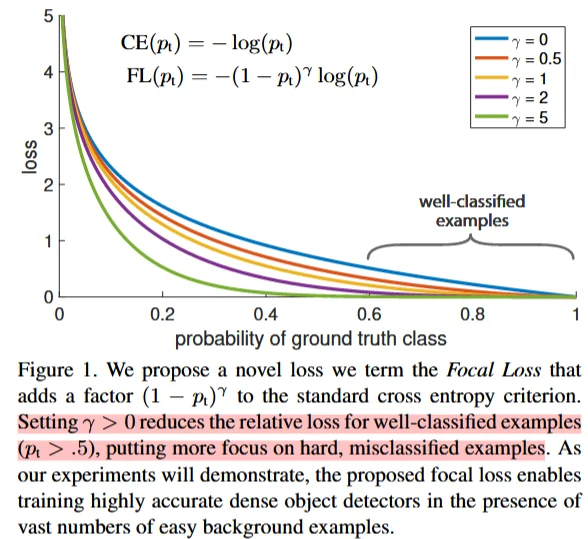深度学习基础理论————常见评价指标以及Loss Function
评价指标
准确率/精确率/召回率
| Positive (预测到的正例) | Negative (预测到的反例) | |
|---|---|---|
| True (预测结果为真) | TP | TN |
| False (预测结果为假) | FP | FN |
争对正案例的计算:
1、准确率计算方式(ACC):$Acc= \frac{TP+TN}{TP+TN+FP+FN}$
2、精确率计算方式(Precision):$\frac{TP}{TP+FP}$
3、召回率计算方式(Recall):$\frac{TP}{TP+FN}$
4、F1计算方式:$\frac{2\times Precision \times Recall}{Precision+ Recall}$
| 指标 | 优点 | 缺点 |
|---|---|---|
| 准确率 | - 直观且易理解 | - 在类别不平衡的情况下可能误导模型评估 |
| 精确率 | - 衡量预测为正类的样本中,实际为正类的比例;适用于避免假阳性 | - 可能忽视召回率,导致漏掉正类样本(假阴性) |
| 召回率 | - 衡量模型对正类样本的识别能力;适用于避免假阴性 | - 可能导致精确率较低,增加误报(假阳性) |
| F1 分数 | - 平衡精确率和召回率,适用于不平衡的任务 | - 不能单独反映精确率或召回率,可能不适用于需要单独关注某一项的场景 |
BLEU
BLEU 采用一种N-gram的匹配规则,原理比较简单,就是比较译文和参考译文之间n组词的相似的一个占比
原文:今天天气不错
机器译文:It is a nice day today
人工译文:Today is a nice day
1-gram:

命中5个词,那么计算得到匹配度为:$5/6$
3-gram:

计算得到匹配度为:$2/4$
在通过结合召回率和惩罚因子之后得到BLEU计算公式为:
使用例子,直接使用第三方库sacrebleu
import sacrebleu
hyps = ['我有一个帽衫', '大大的帽子']
refs = ['你好,我有一个帽衫', '帽子大大的']
bleu = sacrebleu.corpus_bleu(hyps, [refs], tokenize='zh')
print(float(bleu.score))
# 59.809989126151606
Loss Function
Cross-Entropy Loss(交叉熵损失)
交叉熵损失用于分类任务,它度量的是预测概率分布与真实标签分布之间的差异。通常用于多分类问题。交叉熵损失公式(多分类)如下:
\[L = -\sum_{i=1}^{N}y_ilog(p_i)\]其中$N$为类别数量,$y_i$真实标签数据,$p_i$模型预测概率。二分类交叉熵损失为:$Loss=−[ylog(p)+(1−y)log(1−p)]$
在pytorch中对于交叉熵损失函数主要参数:
- 1、label_smoothing (float, optional):通过平滑标签的方式来避免模型过度自信,提高模型的泛化能力并缓解类别不平衡问题的技术。假设模型有 C 个类别,标签为 y,真实标签的平滑值为 ε,则:对于真实类别 y = 1,标签值变为 1 - ε;对于其他类别 y ≠ 1,标签值变为 ε / (C - 1)
- 2、ignore_index (int, optional):忽略某些特定的标签,通常用于标记某些数据的特殊情况,如填充(padding)区域、无效标签或其他不需要参与损失计算的标签
- 3、reduction (str, optional):’none’、’mean’ 和 ‘sum’分别表示对最后 不汇总、平均值、求和
- 4、weight:相当于在计算损失过程中给每一个标签额外补充一个权重
对于交叉熵损失计算从代码角度出发需要考虑的就是输入数据格式:
InputShape:$(N,C)$ 或者 $(N,C,d_1,…,d_K)$。Target:$(N)$ 或者 $(N,C,d_1,…,d_K)$ 其中 C代表类别,N代表batch_size。从数据格式上可以看出也就是保证N、C在同一维度即可
⭐值得注意的是,在pytorch的交叉熵损失里面已经计算了softmax/sigmoid,所以模型输出如果用交叉熵损失函数就不需要用softmax/sigmoid处理
Mean Squared Error(均方误差)
均方误差损失用于回归任务,度量预测值与真实值之间的差异。MSE 计算的是预测值和实际值的平方误差的平均值。MSE 公式:
\[L = \frac{1}{N}\sum_{i=1}^{N}(y_i- p_i)^2\]其中$N$为类别数量,$y_i$真实标签数据,$p_i$模型预测概率。例子:比如说预测类别(假设为3),模型输出之后通过sigmoid/softmax处理之后得到:
| 预测 | 真实 |
|---|---|
| 0.3 0.3 0.4 | 0 0 1 (A) |
| 0.3 0.4 0.3 | 0 1 0 (B) |
| 0.1 0.2 0.7 | 1 0 0 (C) |
均方误差计算:$\frac{(0.3-0)^2+(0.3-0)^2+(0.4-1)^2+…}{3}=0.81$
交叉熵计算:$\frac{-(0\times log0.3+ 0\times log0.3+ 1\times log0.4+ …)}{3}=1.37$
Focal Loss
Focal Loss主要用于处理样本失衡问题(样本里面标签不平衡问题,比如说分类任务标签大部分是类别A只有少部分是标签B),其原理也很简单可以直接在原交叉熵基础上补充一个 因子即可。
\[FL(p_t)=-\alpha_t(1-p_t)^{\gamma}log(p_t)\]
$\gamma$:调节因子,用于控制对易分类样本的惩罚程度。它是一个非负实数,通常设置为大于 0 的值。当$\gamma$>0 时,随着$p_t$的增加,$(1-p_t)^{\gamma}$的值会迅速减小,从而降低易分类样本的损失值。这样可以使得模型更加关注那些难以分类的样本。(换言之,如果样本里面大部分都是A那么计算得到 $p_t$也就会越大,那么可以增加 $\gamma$值来减小这部分值对于损失值的影响)
$\alpha$: 平衡因子,用于调整正类和负类之间的权重。它是一个可调参数,通常设置为$\alpha$对于正类和 1−$\alpha$对于负类。当数据集中正负样本数量不均衡时,可以通过调整$\alpha$来平衡两类样本的贡献。例如,在一个正负样本比例为 1:9 的数据集中,可以将$\alpha$设置为 0.9,以增加正类样本的权重(一般而言对于这个参数直接使用我的标签权重即可)
import torch
import torch.nn as nn
import torch.nn.functional as F
class FocalLoss(nn.Module):
"""Focal Loss implementation."""
def __init__(self, gamma=1.5, alpha=0.25):
super().__init__()
self.gamma = gamma
self.alpha = alpha
def forward(self, pred, label, mask_labels=None):
"""Calculates focal loss with optional mask_labels."""
loss = F.binary_cross_entropy_with_logits(pred, label, reduction='none')
pred_prob = pred.sigmoid()
p_t = label * pred_prob + (1 - label) * (1 - pred_prob)
loss *= (1.0 - p_t) ** self.gamma
if self.alpha > 0:
loss *= label * self.alpha + (1 - label) * (1 - self.alpha)
if mask_labels is not None:
loss *= mask_labels.float()
return loss.sum() / mask_labels.sum()
return loss.mean()
if __name__ == '__main__':
h, w = 500, 500
labels_parent = torch.randint(0, 2, (h, w), dtype=torch.float32)
tmp_labels = torch.zeros(1000, 1000)
tmp_labels[:h, :w] = labels_parent
tmp_labels_mask = torch.zeros(1000, 1000)
tmp_labels_mask[:h, :w] = 1
pred = torch.randn(1, 1000, 1000)
focal_loss = FocalLoss()
loss = focal_loss(pred, tmp_labels.unsqueeze(0), tmp_labels_mask)
print(loss)
对于 FocalLoss另外一个改进为:CB Loss用于改进样本分布不均衡问题:
\[\mathcal{L} = - \frac{1 - \beta}{1 - \beta^{n_y}} \sum (1 - p_y)^\gamma \log(p_y)\]L1 loss
L1 loss:算预测值与真实值之间的绝对差值来衡量模型的预测误差,公式为:
\[L = \frac{1}{N}\sum_{i=1}^{N}|y_i- \hat{y}_i|\]Huber Loss
Huber Loss用于回归任务的损失函数,它结合了均方误差(MSE)和绝对误差(MAE)的优点,可以减少对异常值(outliers)的敏感性,同时保持较好的梯度性质
\[\mathrm{Huber~Loss}= \begin{cases} \frac{1}{2}(y-\hat{y})^2 & \mathrm{if}|y-\hat{y}|\leq\delta \\ \delta*(|y-\hat{y}|-\frac{1}{2}*\delta) & \mathrm{otherwise} & & \end{cases}\]参考
1、https://pytorch.org/docs/stable/generated/torch.nn.CrossEntropyLoss.html
2、https://pytorch.org/docs/stable/generated/torch.nn.L1Loss.html#torch.nn.L1Loss
3、Focal Loss for Dense Object Detection
4、https://blog.csdn.net/zhang2010hao/article/details/84559971
5、https://openaccess.thecvf.com/content_CVPR_2019/papers/Cui_Class-Balanced_Loss_Based_on_Effective_Number_of_Samples_CVPR_2019_paper.pdf
